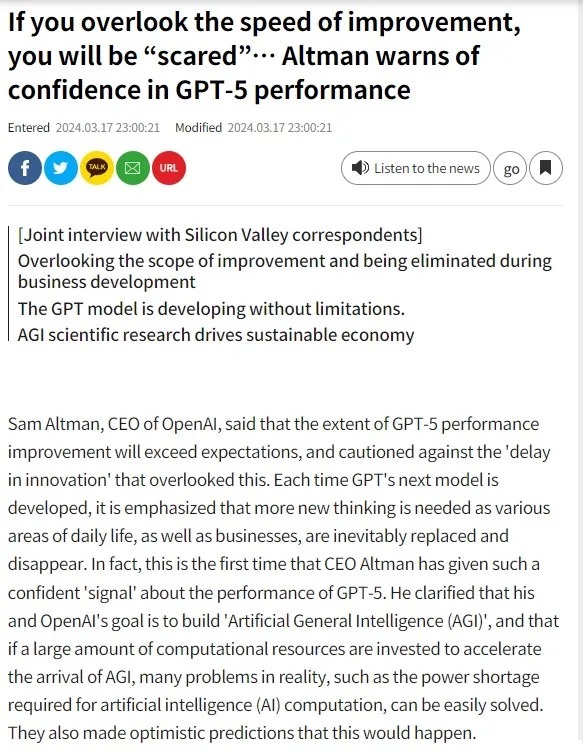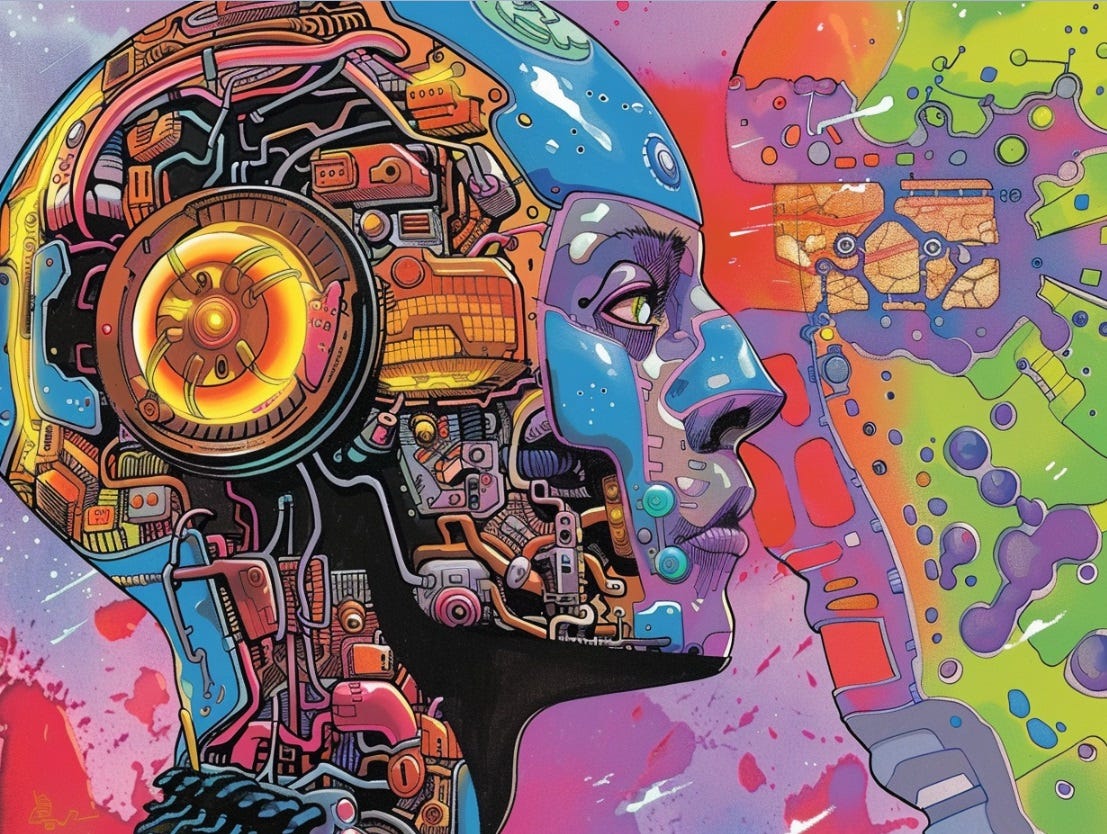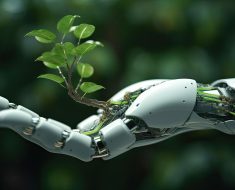Quote of the Issue
“The last rain on Mars was three billion years ago—and it brought no life to the lands on which it fell. Next time, it will be different.” – Arthur C. Clarke, The Hammer of God
The Essay
🤖 AI and the economy: scenarios for a world with artificial general intelligence
Summary: This issue’s essay discusses the potential impact of human-level “artificial general intelligence” on employment. While some economists believe AGI could lead to mass job displacement, others argue that AI will augment human capabilities and create new jobs. A new study, however, suggests that AI’s impact will depend on whether there is a limit to the complexity of tasks humans can perform. If there is a limit, full automation could lead to a collapse in wages unless explosive growth is achieved. Yet AGI is still far from reality, and current AI adoption by businesses is limited. For now, view AI as a powerful technology that will bring both challenges and opportunities, similar to previous technological advancements.
Human-level artificial intelligence, also called artificial general intelligence, is science fiction. It doesn’t exist — and perhaps never will. But there are plenty of computer scientists who think otherwise. They’re confident that recent advances in generative AI, such as ChatGPT, are important steps toward AGI. Indeed, some of them think AGI will arrive within the next decade. (For what it’s worth, the consensus prediction at forecast aggregator Metaculus sees “the first general AI system be devised, tested, and publicly announced” as happening in December 2031. Just two years ago, the forecast was 2057.)
Plenty of AGI enthusiasts have noticed this story about OpenAI CEO Sam Altman and GPT-5 that’s currently winging its way across social media (translated from Korean):

It’s the prospect of more or less imminent AGI that leads to the biggest public concern about the economic impact of this emerging technology: Will the machines eventually take all the jobs? History strongly suggests they won’t. They haven’t so far, of course, and such extreme analysis ignores multiple paths forward to a future of abundant employment. In the recent essay “Applying AI to Rebuild Middle Class Jobs,” MIT economist David Autor argues that the industrialized world is facing a labor shortage due to declining birth rates and a shrinking labor force — a demographic reality that will persist regardless of AI’s impact. “The industrialized world is awash in jobs, and it’s going to stay that way,” Autor writes.
In this future of ample jobs, AI could help restore the middle-skill, middle-class jobs that have been eroded by automation and globalization. Rather than replacing human workers entirely, AI would be a tool to augment and enhance human capabilities by making information and calculation more accessible. This would enable a larger set of workers who possess some level of related training to perform the sorts of higher-stakes decision-making tasks that are currently limited to elite experts in fields such as medicine, law, and engineering.
Concerning AGI specifically, Autor thinks those folks propagating scare stories about mass technological unemployment overplay AI as an automating tool and underplay AI as a tool of augmentation and creativity:
For example, the charter of OpenAI, developer of ChatGPT and DALL-E, defines Artificial General Intelligence (AGI) as “highly autonomous systems that outperform humans at most economically valuable work.” In a 2023 New York Times bestselling book, the AI pioneer Mustafa Suleyman writes, “If the coming wave really is as general and wide-ranging as it appears, how will humans compete?” The most charitable thing I can say about these ominous statements is that they are likely wrong — a flattening of the complexity of innovation into a single dimension of automation. Do these technological visionaries believe that Black and Decker tools make contractors’ skills less valuable and that airplanes outperform their passengers? The latter question is of course nonsensical. Airplanes are not our competitors; we simply couldn’t fly without them. Replicating our existing capabilities, simply at greater speed and lower cost, is a minor achievement. The most valuable tools complement human capabilities and open new frontiers of possibility. The most pedestrian ones incrementally outperform existing tools. My Maytag washing machine harnesses more computer processing power than the first Apollo mission so that I can start its spin cycle from anywhere on the planet. But that washing machine is never going to reach the moon. If AGI simply gives humanity a better washing machine rather than a new moonshot, AGI has not failed us, we have failed ourselves.
With science fiction, however, anything is possible: from faster-than-light travel to heroic aliens who fly and shoot lasers from their eyes. So if you can imagine a humanoid robot with human-level intelligence — or maybe a machine exceeding human mental and physical capabilities — you can imagine a future where machines are capable of taking pretty much all the jobs. (Whether or not we would let them take all the jobs is a different question. Artisanal bakers unite!)
Despite the still science-fictional nature of AGI, it’s reasonable to try and place it within a valid economic framework as we consider possible implications for businesses and workers. That’s just what University of Virginia economists Anton Korinek and Donghyun Suh attempt to do in their new NBER working paper “Scenarios for the Transition to AGI.” (First things first: The economists define AGI as “AI that can perform all cognitive tasks at human levels and thus automate them.”)
Like many other economic analyses of AI and labor, this paper incorporates the idea that human work can be broken down into individual tasks of varying complexity. As technology progresses, it can automate more and more complex tasks. From there, Korinek and Suh look at two possible scenarios: one where there is no limit to the complexity of tasks humans can do, and another where there is a limit.
In the unlimited complexity scenario, new technologies automate a growing number of tasks, but there are always some tasks left that only humans can do. As such, wages can keep rising if the remaining human tasks are complex enough.
In the limited complexity scenario, however, there comes a point where AI can handle all tasks, leading to full automation. When automation is low, human labor is scarce and wages are high. But once automation exceeds a certain threshold, even if some human-only tasks remain, the scarcity of labor is suddenly relieved and wages drop sharply. In this model, wages follow a hump-shaped path. At first, automation boosts economic productivity, raising wages. But later on, it displaces human labor, causing wages to fall.
Unless … AI allows the automation of R&D and thus the automation of tech progress itself — a “growth Singularity.” From the paper:
Rapid technological progress from the automation of R&D allows workers to benefit from the advancement of AI once sufficient automation has taken place. More generally, the force described in this subsection is plausible, and sufficient progress in AI will likely indeed lead to rapid technological advances and increases in living standards.
Two caveats: a lack of materials and energy are possible constraints. But perhaps AI would make both asteroid mining and nuclear fusion possible.
But back to reality. It’s still early days and all that. Few companies are systematically using GenAI so far, and most see it taking years to move beyond the current hype. If so, it will take time for AI — like many other general-purpose technologies, from electrification to the PC — to generate the productivity impacts that significantly reshape the broader economy. Lots of great info on this from a new piece in The Economist, “How businesses are actually using generative AI.” For example:
- Most companies aren’t systematically using AI tools like ChatGPT or Google’s Gemini, although some employees experiment with them.
- The US Census Bureau’s survey reveals that only five percent of American businesses currently use AI, including both generative and older types, with another seven percent planning to adopt it within six months.
- AI usage varies significantly across industries, with 17 percent of information firms using it for products, compared to just three percent of manufacturers and five percent of health-care companies.
- Just 12 percent of companies think generative AI has replaced or will replace human workers within a year. Despite some tech companies claiming AI-related job cuts, there’s scant evidence of increased layoffs in developed countries.

Generative AI is also generating new types of white-collar work. Companies including Nestlé, a coffee-to-cat-food conglomerate, and KPMG, a consultancy, are hiring “prompt engineers” expert at eliciting useful responses from AI chatbots. One insurance firm employs “explainability engineers” to help understand the outputs of AI systems. A consumer-goods firm that recently introduced generative AI in its sales team now has a “sales-bot manager” to keep an eye on the machines.
Predictions about the exact nature of future jobs are as sketchy as those about when AGI will emerge. While some experts are cooking up forecasts, scientists and engineers are pushing forward the technology, and entrepreneurs and business executives are figuring out real-world applications. We should be tracking both closely. Fore now, the smart perspective is to expect neither doom or boom. Rather think of AI as powerful technology, along the lines of ones we’ve had before and about which economic history offers useful context. Well, at least until we get to the Singularity.





